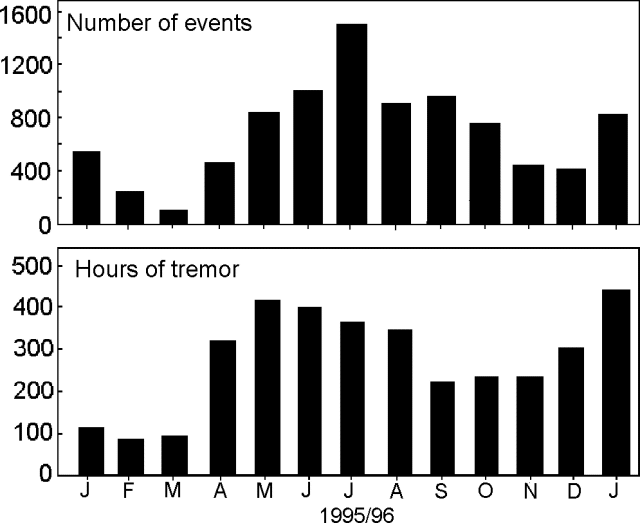Report on Arenal (Costa Rica) — January 1996
Bulletin of the Global Volcanism Network, vol. 21, no. 1 (January 1996)
Managing Editor: Richard Wunderman.
Arenal (Costa Rica) Small Strombolian eruptions continue
Please cite this report as:
Global Volcanism Program, 1996. Report on Arenal (Costa Rica) (Wunderman, R., ed.). Bulletin of the Global Volcanism Network, 21:1. Smithsonian Institution. https://doi.org/10.5479/si.GVP.BGVN199601-345033
Arenal
Costa Rica
10.463°N, 84.703°W; summit elev. 1670 m
All times are local (unless otherwise noted)
During December 1995 and January 1996, Crater C continued its ongoing emission of gases, lava flows, and sporadic Strombolian eruptions. The intensity of Strombolian activity remained high, but showed some decline during this interval. Ash columns reached up to 1 km above the crater.
Lava that began extruding in July 1995 ceased advancing during much of January 1996. In contrast, new lava began extruding during January; it followed previously established channels and reached the 1,100-m contour.
During some past years, a general tendency toward deflation of the edifice had been noted. For the W and N sectors, inclinometers detected a 1995 deflation averaging 15.4 µrad/year. In harmony with this observed deflation, 1995 distance surveys over the local net registered an overall contraction of 21.2 ppm/year.
During December and January, seismic station VACR (2.7 km NE of the main crater) registered a moderate number of local events (figure 75). The majority of these events were thought to be associated with Strombolian eruptions; some were sufficiently strong to be recognized at station JTS (30 km SW of the crater). Tremor during these same two months registered for 306 and 420 hours, respectively (figure 75).
 |
Figure 75. Arenal monthly low-frequency seismicity (<3.5 hz) and tremor, January 1995-January 1996. Data courtesy of OVSICORI-UNA. |
Geological Summary. Conical Volcán Arenal is the youngest stratovolcano in Costa Rica and one of its most active. The 1670-m-high andesitic volcano towers above the eastern shores of Lake Arenal, which has been enlarged by a hydroelectric project. Arenal lies along a volcanic chain that has migrated to the NW from the late-Pleistocene Los Perdidos lava domes through the Pleistocene-to-Holocene Chato volcano, which contains a 500-m-wide, lake-filled summit crater. The earliest known eruptions of Arenal took place about 7000 years ago, and it was active concurrently with Cerro Chato until the activity of Chato ended about 3500 years ago. Growth of Arenal has been characterized by periodic major explosive eruptions at several-hundred-year intervals and periods of lava effusion that armor the cone. An eruptive period that began with a major explosive eruption in 1968 ended in December 2010; continuous explosive activity accompanied by slow lava effusion and the occasional emission of pyroclastic flows characterized the eruption from vents at the summit and on the upper western flank.
Information Contacts: Rodolfo Van der Laat, Vilma Barboza, Erick Fernández, Jorge Barquero, Franklin de Obaldia, Tomás Marino, and Rodrigo Sáenz, Observatorio Vulcanológico y Sismológico de Costa Rica, Universidad Nacional (OVSICORI-UNA), Apartado 86-3000, Heredia, Costa Rica.

